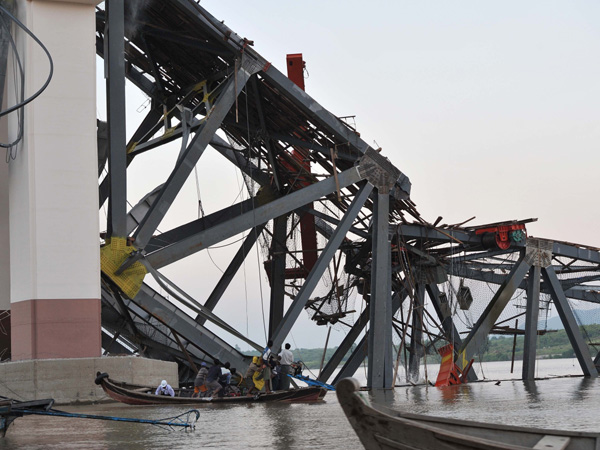13 killed in strong Myanmar quake—NGO

People on a boat work near a damaged bridge in Kyauk Myaung township, east of Shwebo, following a powerful earthquake that hit Myanmar killing at least 13 people, injured dozens and sparking panic in the major central city of Mandalay on November 11, 2012. The shallow 6.8-magnitude quake struck in a rural area 116 kilometres (72 miles) north of Mandalay followed by a series of aftershocks, the US Geological Survey (USGS) said. AFP / SOE THAN WIN
SHWEBO, Myanmar—A powerful earthquake which hit Myanmar Sunday killed at least 13 people, injured dozens and sparked panic in the major central city of Mandalay, residents and aid workers said.
The shallow 6.8-magnitude quake struck in a rural area 116 kilometers (72 miles) north of Mandalay followed by a series of aftershocks, the US Geological Survey (USGS) said.
Another strong quake with a magnitude of 5.8 shook the same region late Sunday, it added. The tremor was felt by an AFP team near the town of Shwebo, which is north of Mandalay and close to the epicenter of the earlier quake.
There was no immediate information on whether the latest quake caused further deaths or major damage.
Four laborers flung into the Irrawaddy river when a partly-built bridge collapsed in the region were among those believed to have died, according to a situation report from the Save the Children charity.
Article continues after this advertisementDamage to a monastery in the nearby village of Kyauk Myaung left two people dead and a further fatality was reported in Mandalay, it said. Six more people were killed in Sint Ku township, including two who died when a gold mine caved in.
Article continues after this advertisementWitnesses at the site of the bridge collapse described how the quake caused a crane that was supporting the structure to topple.
“The ropes could not hold the body of the bridge and it collapsed onto ships on the river below.
The steel frames fell onto the boats, which then sank into the water,” ferry driver Aung Naing Linn, 45, told AFP.
“People jumped from the boats into the water. It did not take long for the ships to sink, just two or three minutes,” he said.
An official from Myanmar’s Relief and Resettlement Department confirmed a death toll of seven so far, with four still considered missing from the bridge construction site.
He told AFP information was still patchy and the number of dead could rise.
State media reported four deaths and more than 50 injured.
Save the Children, which has an office in Mandalay, said reports indicated that 25 were injured in the bridge collapse on the Irrawaddy, with 10 taken to hospital.
It said 20 people were thought to have been hospitalised in Shwebo and a further 10 were being treated in Mandalay.
The aid group said monasteries in several areas had been affected, including in Amarapura, a former royal capital popular with tourists.
In Mandalay, the country’s second-biggest city, residents fled shaking homes and hotels in terror.
“I ran from my bed carrying my daughter out to the street. There were many people in the road. Some were shouting and others felt dizzy,” Mandalay resident San Yu Kyaw told AFP by telephone.
No major damage was reported in the city, although construction standards are generally poor in the country formerly known as Burma, one of Asia’s most impoverished nations.
A large crack stretching from the second to the sixth floor of Mandalay’s highest building, the 25-storey Mann Myanmar Plaza, appeared after the quake, a local resident said.
The quake hit at 7:42 am (0112 GMT) at a depth of just 10 kilometers.
It was followed by two shallow 5.0-magnitude aftershocks within 20 minutes, according to the USGS.
“The quake was quite strong. I was shopping in the market at the time and I saw women crying in fear when they felt it,” said 23-year-old Win Win Nwe, a resident in Shwebo.
It comes little more than a week before US President Barack Obama is due in Myanmar on a historic visit, as the West begins to roll back sanctions to reward dramatic political reforms under President Thein Sein.
The quake was felt in neighboring Thailand including in Bangkok.
Earthquakes are relatively common in Myanmar. The USGS said six strong earthquakes, of 7.0-magnitude and more, struck between 1930 and 1956 near the Sagaing Fault, which runs north to south through the centre of the country.
Kyaw Kyaw Lwin, an official at the National Earthquake Information Division in the capital Naypyidaw, said it was the strongest tremor in the area since a 6.0-magnitude quake in 1991.
More than 70 people were killed in March 2011 when a powerful 6.8-magnitude quake struck Myanmar near the borders with Thailand and Laos.
Aid workers praised Myanmar’s regime for its speedy response to that quake, in contrast to the handling of natural disasters by the previous junta which had ruled the country for decades.